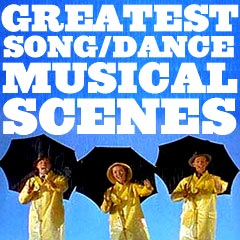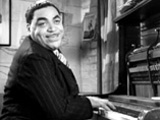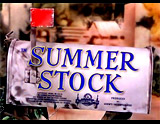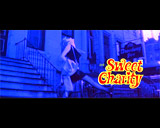
|
Musical Moments and Scenes S - 3 |
| S (continued) | ||||||||
| Movie Title/Year and Scene Descriptions | ||||||||

|
State Fair (1945)
This rose-colored, picture postcard Americana musical from Richard Rodgers and Oscar Hammerstein II (their first filmed musical and their only musical written directly for the screen) was directed by Jose Ferrer and Walter Lang. It had two Oscar nominations, including Best Musical Score, and won only one award: Best Song. It was a musical version of Fox Studio's 1933 non-singing hit (with Will Rogers, Janet Gaynor, and Lew Ayres), a Best Picture nominated film. There was also a 1962 rendition of the film with Ann-Margret and Pat Boone. It also became a Broadway hit musical in 1996. The film's main plot was about the life of the farming Frake family (including father Charles Winninger and mother Fay Bainter) and their three-day adventure at the Iowa State Fair in Des Moines in 1946. The main characters were:
Musical numbers included:
Other hit songs in the score included:
|
       
|
||||||

|
Stop Making Sense (1984) Jonathan Demme and David Byrne's innovative and amazing Talking Heads concert film/art performance piece was shot by cinematographer Jordan Cronenweth during three nights of live shows in 1983 at the Pantages Theater in Hollywood. It began with Psycho Killer (pictured), which Byrne sang solo with an acoustic guitar on an empty stage, accompanied by a simple electronic drum percussion from a tape-deck. Occasionally, Byrne memorably staggered with "machine gun" bursts. The stage slowly added musicians and their equipment (one new band member arrived with every song). There was also:
Other memorable numbers included:
|
     
|
||||||

|
Stormy Weather (1943)
This was one of the greatest and most entertaining of the all-black musicals, along with MGM's Cabin in the Sky (1943) in the same year. The 20th Century Fox film included the ravishing Lena Horne (as pretty singer Selina Rogers), lent by MGM Studios to Fox. She crooned what would become her signature song Stormy Weather (composed in 1933) in a lengthy song-dance sequence (pictured twice). There were other great songs, dance and band routines including:
|
      
|
||||||

|
Stowaway (1936) The adorable Fox star Shirley Temple (as Barbara "Ching-Ching" Stewart) sang this memorably happy song for Depression audiences in this film:
|

|
||||||

|
Strictly Ballroom (1992, Australia) Director Baz Luhrmann's (his feature film debut) bright, gaudy, and off-beat comedy/romance retro-chic dance/musical film featured extensive ballroom dancing scenes, including:
During their spirited and competitive performance, the electricity was deliberately shut off by Charm Leachman (Kris McQuade) and their music stopped playing. The scheming Barry Fife (Bill Hunter), the president of the Australian Dancing Federation, unfairly ruled that they were disqualified, but they continued to dance anyway when encouraged by the crowd - which had created their own rhythmic, clapping beat. Soon after, the duo's music was restored, audience members joined them on the dance floor - and the growing love affair between Fran and Scott was reaffirmed with a kiss. |
 
|
||||||

|
Summer Holiday (1948) This was a mostly-forgotten and unpopular 'musical play' (released 18 months after it was finished) from director Rouben Mamoulian (his third Hollywood musical) and producer Arthur Freed. It was a musical remake of Eugene O'Neill's 1933 play Ah, Wilderness! The play first opened on Broadway in 1933, and was made into a film of the same name in 1935 by director Clarence Brown. This conventional MGM film told about the middle-class family of the Millers in Danville, Connecticut, at the turn of the century (in 1906). Dialogue from the play was integrated into the film as song and dance numbers. The two main stars were:
The Technicolored film opened with newspaper editor/father Mr. Nat Miller (Walter Huston) singing Our Home Town (pictured) to introduce the setting (when he placed a pin to locate the state of Connecticut on a United States wall map), followed soon after by a July 4th picnic sequence:
Rooney also sang the upbeat song The Stanley Steamer (pictured) as he drove an open convertible (known as a 'Stanley Steamer') through town. There was also the dazzling scene of Richard's drunken bar-room encounter with floozy chorus girl Belle (Marilyn Maxwell) after breaking up (temporarily) with his girlfriend Muriel. Belle sang I Think You're the Sweetest Kid I Ever Knew (pictured) to Rooney (embracing him close to her) while her dress changed colors from muted yellow to tempting red, reflecting his growing drunkenness. |
  
|
||||||

|
Summer Stock (1950)
This likeable and brisk but uninspiring MGM musical, directed by Charles Waters, was Judy Garland's last MGM film (and last pairing with Gene Kelly on-screen) due to personal problems (including drug addiction). It featured a top-notch Harry Warren score and great dance numbers. Garland starred as small-town New England (Connecticut) farmer Jane Falbury who was having financial difficulties due to poor crop yields over three years. Her spoiled sister, actress Abigail (Gloria DeHaven), invaded with a troupe of actors to use her barn as a theater for their Broadway-bound musical play. The one requirement was that the city-slicker actors had to pitch in and help with daily farm chores. Jane began to find romance with the group's bankrupt writer-director Joe D. Ross (Gene Kelly) who was engaged to stage-struck Abigail. It was notable for Judy Garland's famous male drag solo performance of Get Happy (pictured) (filmed after the movie wrapped when Garland was much slimmer) in the final song-dance number (with music by Harold Arlen and lyrics by Ted Koehler), in the musical show-within-a-show:
In the euphoric performance, she wore black nylon tights, half a tuxedo (the dark dinner jacket), black shoes, and a tilted black fedora hat. Garland also energetically sang If You Feel Like Singing, Sing (pictured), first while showering and continuing as she completely dressed herself one happy morning. She also shared a "nice, easy dance" duet with Gene Kelly in You Wonderful You (pictured). Another of their dance duets, one of Garland's career finest, was The Portland Fancy (pictured) - it began as a square dance and became a lively challenge dance between the two. Kelly also performed Dig-Dig-Dig Dig For Your Dinner (pictured) about how the troupe had to work for their keep. The film was also noted for Kelly's brilliant dance solo (pictured) in which he performed on the bare stage of a dark barn theatre and used various props of his surroundings (shuffling with a single sheet of newspaper, squeaking floor boards) and incorporated them as dance partners. |
     
|
||||||

|
Sunnyside Up (1929)
Janet Gaynor's first all-talking film appearance was in Fox's popular early musical, one of the first musicals created directly for the screen - and featuring the film debut of young 7 year-old Jackie Cooper. Janet Gaynor (as poor working-girl heroine Molly Carr) was again teamed with her silent film romantic partner Charles Farrell (as Jack Cromwell) (they were known as "America's Favorite Lovebirds") for the first time in a talkie. In the familiar Cinderella tale, Gaynor sang:
The finale's bizarre, erotic and uninhibited production number Turn on the Heat (pictured thrice), partly tinted in Multi-color, has been considered the 'first purely cinematic' number of its kind. 36 chorines (emerging from igloos), led by flapper Jane Worth (Sharon Lynne), were dressed as Eskimos. Soon after, when their ice-bound set became hot, and palm trees sprouted on the tropical island, they flung off their fur parkas and wildly danced. Then, when the island went up in flames from underground smoke (lava fissures?), they jumped forward into the water in their skimpy summer bathing suits. |
    
|
||||||

|
Sun Valley Serenade (1941) Scandinavian ice-skating champion and Olympic Gold Medal winner Sonja Henie appeared in a number of Fox films (such as Thin Ice (1937)) (pictured). Her appearance in this 1941 film was one of the best of the lot. It was also band leader-musician Glenn Miller's first film as an actor. This was the first of the only two films featuring his Glenn Miller Band. The setting was the famed Idaho ski resort where Norwegian refugee Karen Benson (Henie) staged an ice show. The film was highlighted by Dorothy Dandridge's famous song-and-dance with the Nicholas Brothers to the Oscar-nominated Best Song Chattanooga Choo Choo (pictured). Other songs played by the Glenn Miller Band included the In the Mood sequence. |
 Thin Ice (1937)  Sun Valley Serenade (1941) |
||||||

|
Sweet Charity (1969) Loosely adapted from director Federico Fellini's Nights of Cabiria (1957, It.), this marked the feature-film debut of excessive director/choreographer Bob Fosse. It was Universal Studio's feature film version of the Neil Simon-Cy Coleman-Dorothy Fields stage musical (originally with Gwen Verdon). The film received three Academy Award nominations (with no wins): Best Art Direction-Set Decoration, Best Musical Score (Cy Coleman), and Best Costume Design (Edith Head). It starred Shirley MacLaine in the title role as dance-hall 'hostess' Charity Hope Valentine. It was best known for:
|
   
|
||||||

|
This RKO film, a screwball comedy-musical directed by George Stevens, was considered one of the greatest Astaire-Rogers teamings because it integrated many of the Jerome Kern songs into the story. Its sole Oscar nomination and win was for Best Original Song (music by Jerome Kern and lyrics by Dorothy Fields). The musical marked the sixth film starring Astaire and Rogers.
It featured many famous musical numbers, including:
|
      
|
||||||
(alphabetical by film title) Introduction | A-1 | A-2 | B-1 | B-2 | B-3 | C-1 | C-2 | D-1 | D-2 | E | F-1 | F-2 | G-1 | G-2 H-1 | H-2 | I-J | K | L-1 | L-2 | M-1 | M-2 | N-O | P-1 | P-2 | R-1 | R-2 | S-1 | S-2 | S-3 | T | U-V | W | X-Z |